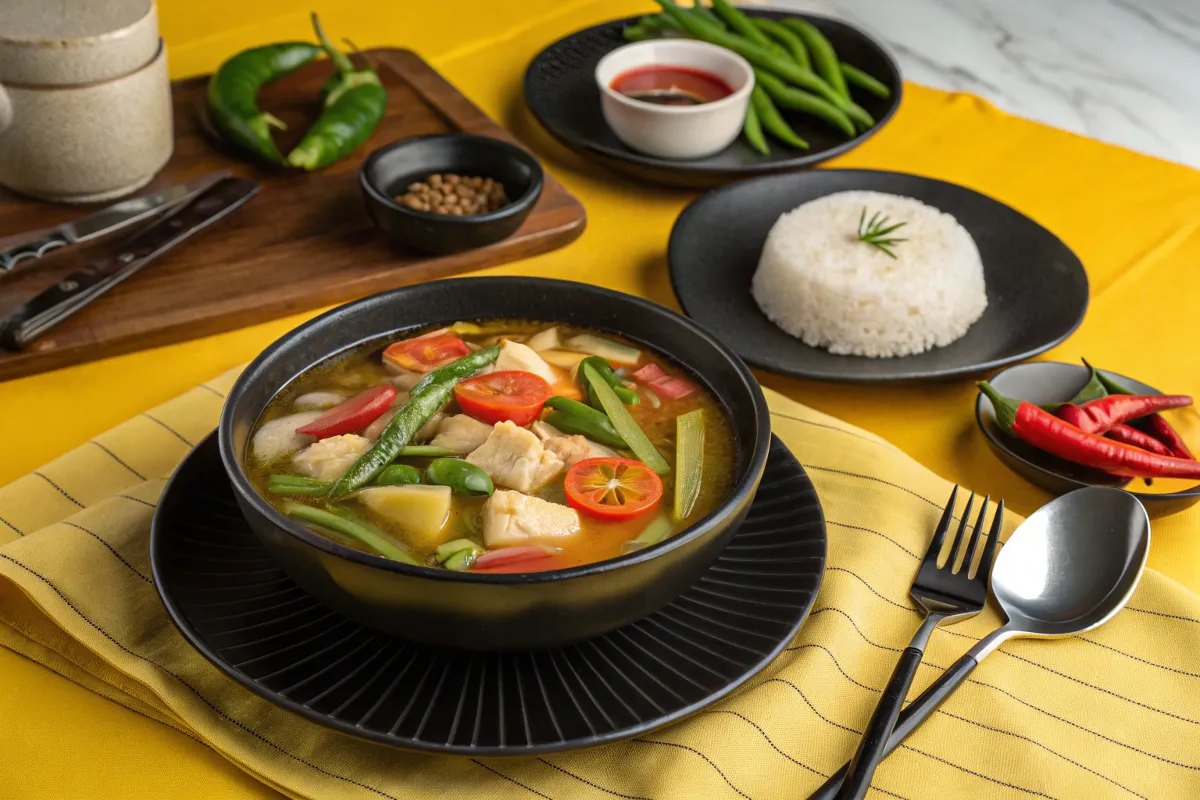Introduction: What Is Sinigang Mix Made Of?
Sinigang is a famous Filipino dish loved for its sour and savory taste. Families across the Philippines enjoy it as a comforting soup made with meat, vegetables, and a flavorful broth. But have you ever wondered, what is sinigang mix made of? This seasoning helps create the signature flavor of sinigang quickly and easily.

The main ingredient in sinigang mix is tamarind, a tropical fruit known for its natural sourness. Producers combine tamarind with salt, spices, and powdered vegetables to give the mix its unique taste. Some brands even add flavor enhancers to make the broth richer. If you’re curious about how tamarind plays a big role in this dish, check out Tamarind Concentrate in Sinigang.
Sinigang is special because it is so versatile. You can prepare it with pork, shrimp, fish, or chicken, depending on your preference. The soup also includes vegetables like radish, eggplant, tomatoes, and water spinach (kangkong), which add nutrients and texture. To learn more about why this dish is so loved, visit What’s Special About Sinigang.
Making sinigang is easy with the help of sinigang mix. You can enjoy the dish in less time, without losing its authentic flavor. If you want to cook it yourself, try this step-by-step Sinigang Recipe and discover why this Filipino favorite is perfect for any occasion.
Table of contents
- Introduction: What Is Sinigang Mix Made Of?
- What Are the Ingredients in Sinigang soup ( What Is Sinigang Mix Made Of? )
- How to Use Sinigang Mix in Your Cooking 9What Is Sinigang Mix Made Of?)
- Tips for Making the Perfect Sinigang Soup
- Easy Sinigang Recipe (What Is Sinigang Mix Made Of?)
- Why You Should Try Cooking Sinigang soup at Home
- Common Mistakes to Avoid When Cooking Sinigang Recipe
- FAQs About Sinigang Soup
- Conclusion of Sinigang soup
What Are the Ingredients in Sinigang soup ( What Is Sinigang Mix Made Of? )
Sinigang mix is a convenient seasoning that helps people prepare the tangy and delicious Filipino soup known as sinigang. It combines simple yet flavorful ingredients that bring out the traditional taste of this well-loved dish. Let’s break down what’s inside and why each ingredient matters.

Tamarind: The Key to Sourness
Tamarind is the most important ingredient in sinigang mix. It provides the sour flavor that makes the dish stand out. Producers grind tamarind into a powder, making it easy to blend into the soup. Without tamarind, the dish would lose its signature tangy taste.
Salt and Spices Add Depth
Salt plays a big role in enhancing the overall flavor of the soup. It helps bring out the natural taste of the meat and vegetables. Spices such as garlic powder, onion powder, and black pepper work together to give the broth a richer, more balanced flavor. These spices also make the dish smell even more appetizing as it cooks.
Powdered Vegetables for Extra Flavor
Powdered vegetables like tomatoes and onions add more taste to the soup. These vegetables are dried and turned into powder, which dissolves easily when mixed with water. This gives the soup a consistent and well-rounded flavor. Adding vegetables in powdered form also saves time when cooking.

Flavor Boosters for a Savory Kick
Some sinigang mixes include flavor boosters, such as monosodium glutamate (MSG). These ingredients enhance the savory taste of the broth, making it more satisfying and delicious. While not every mix uses MSG, it can make the dish taste even more flavorful.
Sinigang mix combines all these ingredients to create the perfect seasoning for this beloved Filipino soup. It simplifies the cooking process while preserving the bold, traditional flavors of the dish. By using sinigang mix, anyone can prepare this hearty soup quickly and enjoy its tangy and comforting taste.
How to Use Sinigang Mix in Your Cooking 9What Is Sinigang Mix Made Of?)
Sinigang mix makes it easy for anyone to cook the iconic Filipino soup. With just a few steps, you can create a dish that tastes both delicious and traditional. Let’s walk through the simple process of using sinigang mix in your cooking.
Step 1: Prepare Your Ingredients of Sinigang soup
Start by gathering all the ingredients for your sinigang. Common choices include pork, shrimp, or fish as the protein. You will also need fresh vegetables like radish, tomatoes, eggplant, and water spinach. Wash and chop everything to make the cooking process smoother.

Step 2: Cook the Meat or Seafood
Heat a pot and cook your chosen meat or seafood with a little oil. For pork or beef, cook the pieces until they are tender. If you are using shrimp or fish, cook them just long enough to avoid overcooking. Cooking the protein first adds flavor to the broth and creates a good base for the soup.
Step 3: Add the Vegetables for Sinigang soup
Once your meat or seafood is ready, add the chopped vegetables. Start with the ones that take longer to cook, such as radish or eggplant. Save leafy greens like water spinach for the final step so they stay fresh and vibrant. Stir the vegetables gently to ensure they cook evenly.
Step 4: Mix in the Sinigang soup Seasoning
Open the sinigang mix packet and sprinkle it into the pot. Stir it well to make sure the seasoning dissolves completely in the broth. The tamarind in the mix gives the soup its signature sour flavor, while the spices add depth. Taste the broth and adjust the amount of mix if needed to suit your preference.
Step 5: Simmer and Serve of Sinigang soup
Let the soup simmer for a few minutes to bring all the flavors together. Stir occasionally to keep everything evenly mixed. Once the vegetables are tender and the broth is flavorful, your sinigang is ready to serve. Pour the soup into bowls and enjoy it with steamed rice for the perfect Filipino meal.
Sinigang mix transforms the cooking process into something simple and enjoyable. By following these steps, you can create a flavorful and comforting dish that brings thetaste of home to your table.
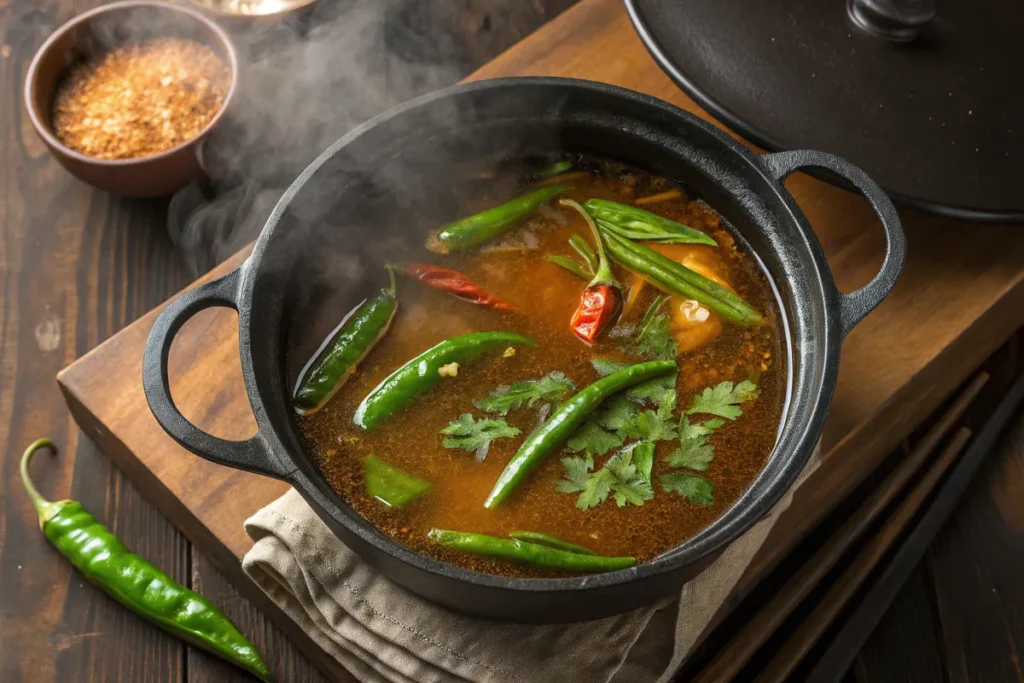
Tips for Making the Perfect Sinigang Soup
Cooking sinigang is simple, but a few tips can help you make it even better. By following these suggestions, you can prepare a soup that is not only flavorful but also memorable.
Choose Fresh Ingredients for Sinigang soup
Fresh ingredients make a big difference in how your sinigang tastes. Pick fresh vegetables like radish, tomatoes, and eggplant. Make sure the meat or seafood you use is also fresh to give the broth the best flavor.
Don’t Overcook the Vegetables
Cook vegetables just long enough so they stay tender but not mushy. Leafy greens like water spinach should be added last because they cook quickly. This way, the vegetables will keep their natural taste and texture.
Adjust the Flavor to Your Liking
Taste the broth as you cook. If you like your soup more sour, you can add more sinigang mix. If the broth feels too strong, add a little water to balance the flavor. Everyone has their own preference, so feel free to adjust it!
Pair It with Steamed Rice
Sinigang is always best when served with warm steamed rice. The rice absorbs the flavorful broth and creates a perfect match for the sour and savory soup. Don’t forget to prepare enough rice to enjoy with your sinigang!
Experiment with Different Proteins
Although pork is a popular choice for sinigang, you can also use other proteins like shrimp, fish, or chicken. Each one gives the soup a unique flavor. For example, shrimp adds a light and fresh taste, while pork gives the soup a richer and heartier flavor.
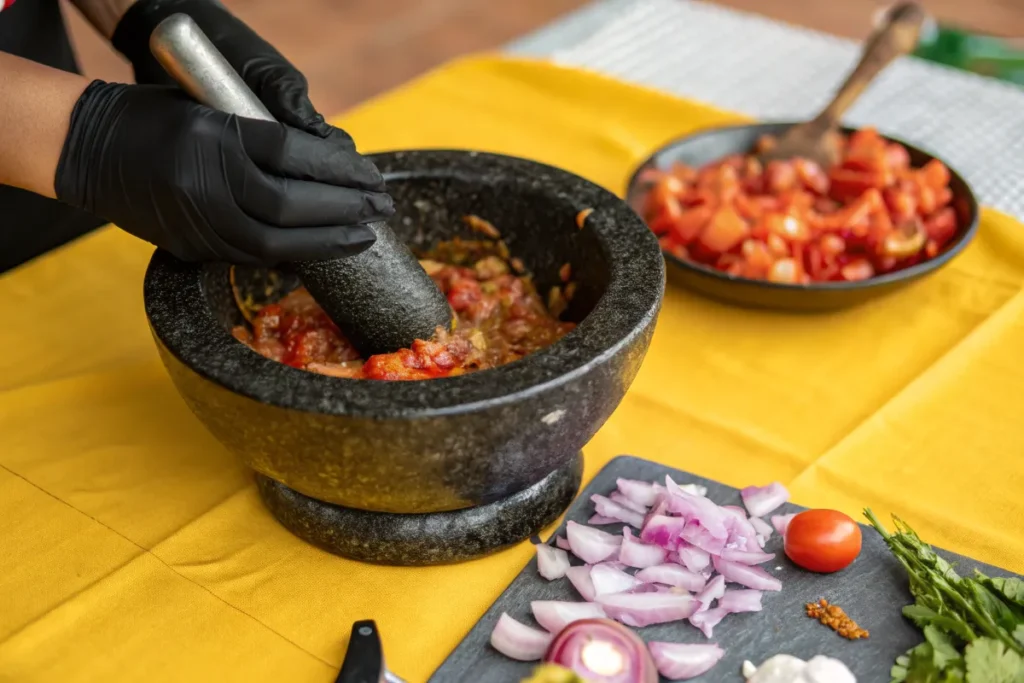
Easy Sinigang Recipe (What Is Sinigang Mix Made Of?)
This simple sinigang recipe will help you prepare a comforting bowl of Filipino sour soup in just a few easy steps. Whether you’re using pork, shrimp, or fish, this recipe ensures you get the classic tangy and savory flavor every time.
Ingredients for Sinigang soup
For the broth:
- 1 pound of pork (belly or ribs), shrimp, or fish (your choice)
- 1 packet of sinigang mix (adjust to taste)
- 6 cups of water
For the vegetables:
- 1 medium radish, peeled and sliced
- 2 medium tomatoes, quartered
- 1 medium eggplant, sliced into half-moons
- 1 cup of water spinach (kangkong)
- 1 medium onion, sliced
Optional add-ons:
- 1-2 long green chili peppers (for a spicy kick)
- Okra or string beans (for extra texture)

Instructions of Sinigang soup
Boil the Meat or Seafood
- In a large pot, bring 6 cups of water to a boil.
- Add your chosen protein (pork, shrimp, or fish) and cook until it becomes tender. For pork, this may take 30-40 minutes; for shrimp or fish, it will only take about 5-10 minutes.
Add the Vegetables
- Once the meat or seafood is cooked, add the onion and tomatoes to the pot. Let them cook for about 5 minutes.
- Next, add the radish and eggplant. Cook these for another 5-7 minutes, or until they start to soften.
Mix in the Sinigang Seasoning
- Open the packet of sinigang mix and gradually sprinkle it into the pot. Stir well to make sure it dissolves evenly in the broth.
- Taste the soup and adjust the seasoning as needed by adding more mix for extra sourness or water to dilute the flavor.
Add the Leafy Greens
- Add the water spinach (kangkong) and let it cook for 1-2 minutes. Leafy greens cook quickly, so it’s best to add them at the very end to keep them fresh and vibrant.
Serve and Enjoy
- Turn off the heat and let the soup rest for a minute.
- Ladle the hot sinigang into bowls and serve it with steamed rice. Add chili peppers on top if you want to spice things up.
This recipe serves 4-5 people and is perfect for a family meal. Enjoy your homemade sinigang with its tangy broth, tender meat, and fresh vegetables.
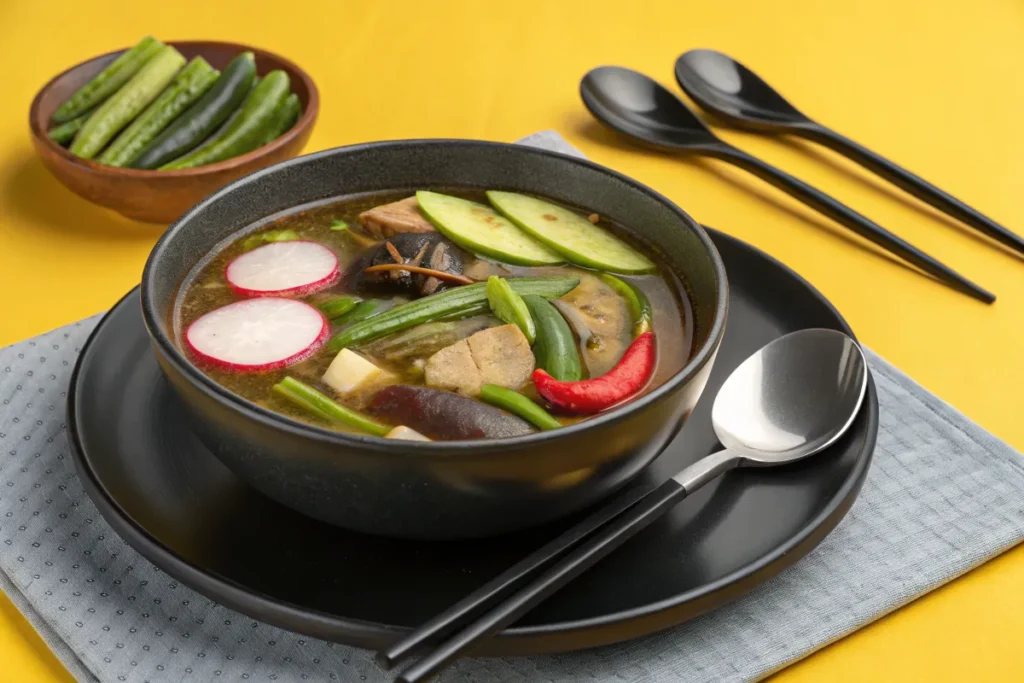
Why You Should Try Cooking Sinigang soup at Home
Sinigang is not just a dish—it’s a part of Filipino culture that brings families together. Cooking sinigang at home is a rewarding experience that lets you enjoy its comforting flavors while learning more about Filipino traditions. Here are a few reasons why you should try making this dish in your own kitchen.
It’s Simple and Convenient
First of all, sinigang is easy to make, especially with sinigang mix. You don’t need to spend hours in the kitchen to enjoy a flavorful, home-cooked meal. All you need are fresh ingredients, a pot, and a packet of seasoning to get started. Furthermore, the steps are straightforward, making it a great recipe for beginners.
It’s Versatile and Customizable
Another reason to try sinigang is its versatility. You can use pork, shrimp, fish, or even chicken as your protein. Additionally, you can include a variety of vegetables based on your preferences, such as radish, eggplant, and okra. If you enjoy a spicier kick, you can easily add chili peppers to the soup. No matter your taste, you can customize sinigang to suit your family’s preferences.
It’s Nutritious and Balanced
Sinigang isn’t just delicious—it’s also packed with nutrients. The soup includes fresh vegetables, which provide essential vitamins and minerals. At the same time, the protein you choose gives the dish a satisfying richness. Paired with rice, sinigang is a complete and balanced meal that nourishes the body. Moreover, it’s a light dish, making it great for any season.
It’s Perfect for Sharing
Finally, sinigang is best enjoyed with others. Whether you’re serving it to your family or cooking it for friends, the dish has a way of bringing people together. The warm, tangy broth and hearty ingredients make everyone feel at home. Because of this, it’s a perfect choice for gatherings or simple family dinners.
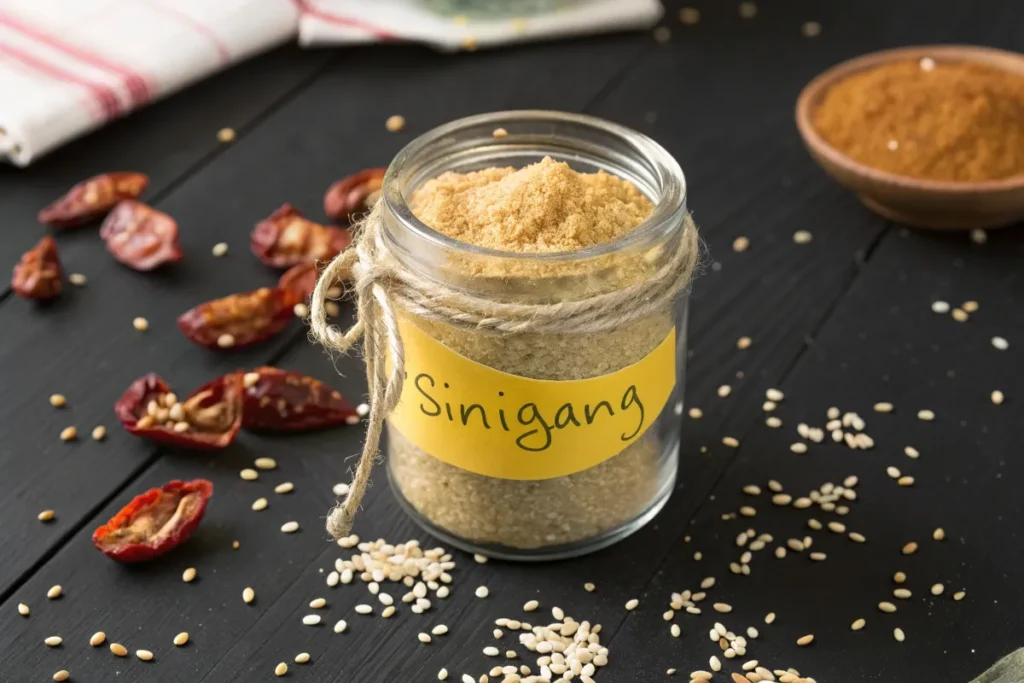
Common Mistakes to Avoid When Cooking Sinigang Recipe
Cooking sinigang might seem simple, but even small mistakes can affect its flavor and texture. Fortunately, these errors are easy to avoid with a little care and attention. Let’s go over the most common mistakes and how to prevent them, so your sinigang turns out perfect every time.
Overcooking the Vegetables
One of the most common mistakes is overcooking the vegetables. When vegetables like radish or eggplant are cooked for too long, they lose their texture and become mushy. To avoid this, always add vegetables in stages. For example, add firm vegetables like radish and eggplant earlier, and then add delicate greens like water spinach at the very end. This way, everything will stay fresh and perfectly cooked.
Using Too Much or Too Little Sinigang Mix
Another mistake people often make is using the wrong amount of sinigang mix. If you use too much, the soup may become too sour or salty. On the other hand, if you use too little, the broth might taste bland. To prevent this, always start with a smaller amount of mix and taste as you go. Gradually add more until the soup has the exact flavor you like.
Forgetting to Season the Meat
Sometimes, people forget to season the meat before cooking it. This can leave the protein tasting plain, even if the broth is flavorful. To fix this, season your meat with a little salt and pepper before adding it to the pot. By doing this, the meat will absorb more flavor and taste better with the soup.
Rushing the Cooking Process
Many people make the mistake of rushing the cooking process. For example, they might cook pork or beef too quickly, leaving the meat tough and chewy. Instead, always allow enough time to tenderize the meat. Simmer it slowly on low to medium heat, which ensures it becomes soft and flavorful. Similarly, let the soup simmer for a few minutes after adding the sinigang mix to allow the flavors to blend properly.
Skipping Fresh Ingredients of Sinigang soup
Finally, skipping fresh ingredients can weaken the overall flavor of the dish. Using stale vegetables or low-quality meat often leads to a soup that tastes less vibrant. Always choose fresh produce and high-quality meat or seafood for the best results. This step might seem small, but it makes a big difference in the final taste of the dish.

FAQs About Sinigang Soup
Yes, Filipino sinigang is healthy because it is packed with fresh vegetables and protein. Additionally, the soup is light and low in fat, making it a nutritious choice.
The main ingredients of sinigang are meat (pork, shrimp, or fish), tamarind for the sour flavor, vegetables like radish and tomatoes, and water spinach. Furthermore, sinigang mix is often used for convenience.
First, boil the meat until tender. Next, add vegetables like radish and tomatoes. Then, stir in the sinigang mix and let it dissolve. Finally, add leafy greens, simmer for a few minutes, and serve.
Sinigang mix is made of tamarind powder, salt, spices, and sometimes powdered vegetables. Additionally, some brands include flavor enhancers for a richer taste.
Yes, sinigang can be healthy for weight loss because it is low in calories and packed with vegetables. Moreover, the broth is light and filling without being heavy.
Yes, you can cook sinigang without tomatoes, but it may alter the flavor slightly. To add extra flavor, you can use more tamarind or other vegetables instead.
Sinigang is often called “sour soup” in English because of its tangy and savory flavor. However, there is no direct translation for its name.
Conclusion of Sinigang soup
Sinigang is more than just a dish—it’s a beloved part of Filipino culture that brings comfort to every table. With its tangy broth, fresh vegetables, and tender meat, it’s no wonder this soup is a favorite among families. Moreover, using sinigang mix makes it quick and easy to prepare, even for beginners.
In addition, sinigang is versatile and can be customized to suit your preferences. Whether you use pork, shrimp, fish, or chicken, the soup always delivers a perfect balance of sour and savory flavors. Furthermore, it’s a healthy and balanced meal, packed with nutrients from fresh ingredients.
If you avoid common cooking mistakes and follow the simple steps, you’ll have no trouble creating a sinigang that everyone will love. Finally, this iconic Filipino soup is perfect for family meals, gatherings, or any time you crave something warm and satisfying.
Print
Sinigang Recipe : Traditional Ingredients
- Total Time: 55 minutes
- Yield: 4 servings 1x
Description
A traditional Filipino sour soup, Sinigang is beloved for its tangy tamarind flavor, vibrant vegetables, and hearty broth. This comforting dish combines fresh ingredients like radish, eggplant, green beans, and tomatoes, simmered to perfection for a warm and flavorful experience.
Ingredients
- 1 lb pork belly (or shrimp, fish, or beef as a variation)
- 4 cups water
- 1 medium red onion, quartered
- 2 medium tomatoes, quartered
- 1 cup tamarind pulp or Sinigang mix (to taste)
- 1 cup radish, sliced
- 1 cup eggplant, sliced
- 1 cup long green beans, trimmed
- 2 green chili peppers (optional, for spice)
- Salt and fish sauce, to taste
Instructions
-
Prepare the Broth
In a large pot, bring water to a boil. Add pork belly, red onion, and tomatoes. Simmer for 30 minutes until the pork is tender. Skim off any impurities. -
Add Tamarind
Add tamarind pulp (or Sinigang mix) to the pot. Stir well to dissolve and adjust the sourness to taste. -
Cook the Vegetables
Add radish and cook for 5 minutes. Then add eggplant, long green beans, and green chili. Let the vegetables cook for another 5-7 minutes or until tender. -
Season the Soup
Add salt and fish sauce to taste. Simmer for 2-3 minutes to combine flavors. -
Serve Hot
Ladle the Sinigang into bowls and serve with steamed white rice. Enjoy!
Notes
- For a seafood variation, substitute pork with shrimp or fish and reduce cooking time.
- To enhance the sourness, add more tamarind or squeeze fresh calamansi juice before serving.
- Adjust spice levels by adding or omitting green chili peppers.
- Prep Time: 10 minutes
- Cook Time: 45 minutes
- Category: Main Dish
- Method: Simmering
- Cuisine: Filipino
Nutrition
- Serving Size: 1 bowl
- Calories: 320 kcal
- Sugar: 4 g
- Sodium: 750 mg
- Fat: 18 g
- Saturated Fat: 7 g
- Unsaturated Fat: 9 g
- Trans Fat: 0 g
- Carbohydrates: 15 g
- Fiber: 3 g
- Protein: 20 g
- Cholesterol: 55 mg
Keywords: Filipino Sinigang Recipe, Tamarind Soup, Sour Soup, Filipino Comfort Food

